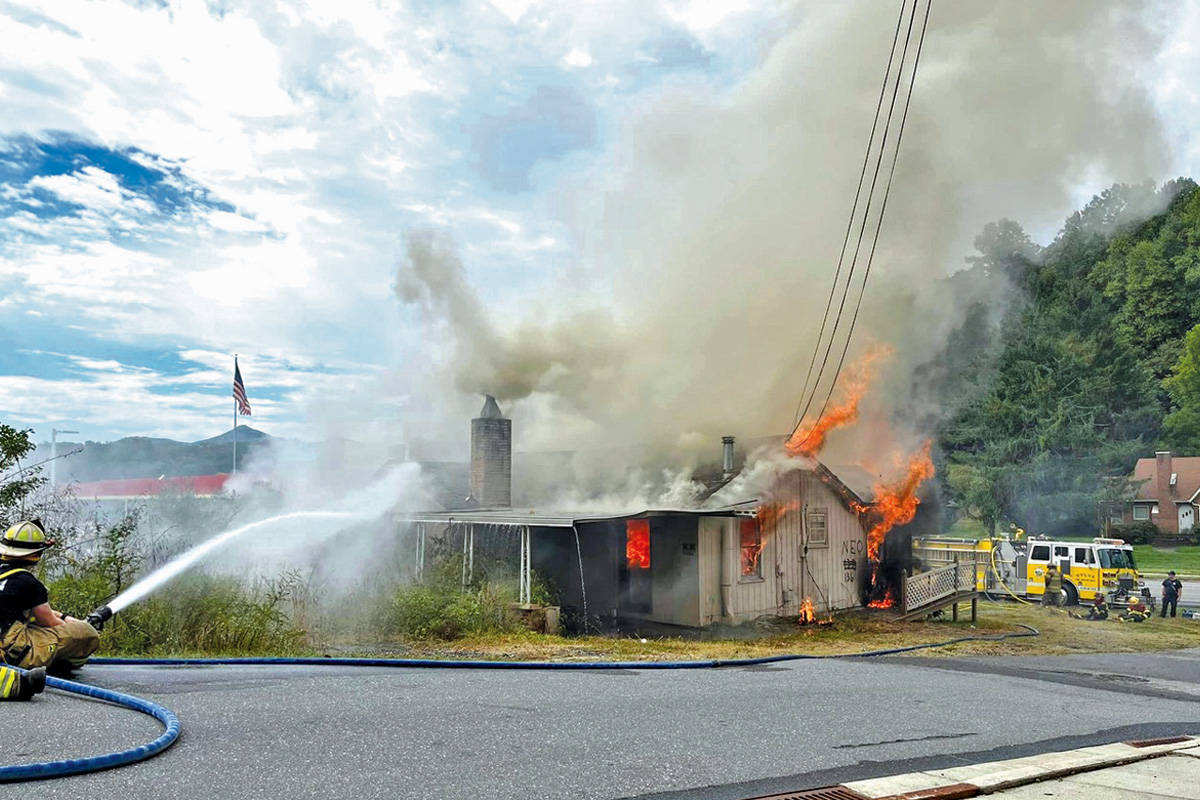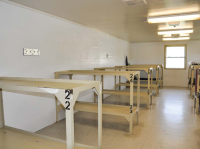Slow burn: NC 107 work marches on
 Sylva Fire Department conducts controlled burn on an NC 107 property slated for demolition. Sylva Fire Department photo
Sylva Fire Department conducts controlled burn on an NC 107 property slated for demolition. Sylva Fire Department photo
The towns of Sylva, Webster, Cullowhee and Cashiers are all connected by five lanes of chaos, better known as N.C. 107.
Due to dangerous conditions on the thoroughfare, plans for upgrades have been in the works for over a quarter of a century and finally, those plans have started to come to fruition. But debate over the road’s future and the merits of the construction project are far from complete.
History
The first recorded upgrades to N.C. 107 came in the 1930s when two bridges were constructed over Scotts Creek just west of Sylva Fire Department and east of the Jackson Paper Mill.
The road remained largely the same until the 1980s, when it was found to have one of the highest crash rates in the state. The road had previously been expanded to four lanes without a dedicated turn lane in the middle, and the stream that once flowed alongside N.C. 107 was encased in six-foot pipes and buried under the road.
To reduce the high crash rate, the road was restriped in the mid-1990s to add a center turn lane, but it was not widened. The additional lane did help improve crash rates, but traffic continued to worsen due to development, and officials requested a study for ways to improve the road.
In 1995, plans for a “Southern Loop” were presented that would add a bypass around N.C. 107, central Sylva and Dillsboro. The N.C. Department of Transportation also explored the idea of a bypass through the Cane Creek area that would have routed traffic between Balsam and Western Carolina University. Both these ideas were met with strong public opposition, part of which was the concern from business owners that the new construction would cause most traffic to bypass their business establishments.
Related Items
The plans set off a debate that would last more than a decade after the Smart Roads Alliance was formed in 2002 to represent Sylva citizens against the roadway improvement plans. The Smart Roads Alliance sought to protect not only local businesses, but also mountain landscapes where construction would have taken place.
It wasn’t until 2013, after years of community input and back and forth with DOT, that upgrades to N.C. 107 were deemed a higher funding priority than the N.C. 107 connector project. In that same year, the N.C. 107 connector was removed from Jackson County’s comprehensive transportation plan and replaced with the current plan.
After a long design process with more input from the public along the way, plans for upgrades to N.C. 107 were set in motion by late 2019.
“Essentially, we’re at the point where we have to move forward with the engineering design that we have,” NCDOT Division Engineer Brian Burch told residents at a September meeting that year. “The opportunity for public information or public comment has passed. We either move forward into right-of-way and construction, or we stop completely and essentially restart the process, which in my estimation would take 10 more years.”
The next delay to slow the process came in 2020 with the onset of the COVID-19 Pandemic. Right-of-way acquisitions had been set to start in early 2021 with construction planned for early 2023, but after combined effects of the pandemic and financial shortfalls faced by the DOT, the project was pushed back roughly two years.
And while Sylva and Jackson County facilitated immense public input throughout the entire process, the project, planning and funding were always firmly in the hands of the department of transportation.
Sylva Town Commissioner Brad Waldrop posted a poll on his Facebook page asking people what official role they understood the Town of Sylva played in the approval or design of the N.C. 107 projects. Reactions and understanding were mixed among the more than 70 respondents.
Still, some residents opposing the project pleaded with town and county officials to do something about the impending construction even though they can’t alter the project.
The only financial contribution the Town of Sylva made to the project was to budget $200,000 for sidewalks for its part in matching funds for sidewalks when the time came. However, because the DOT built more into their project design than expected, the town will only spend $40,000 on sidewalks associated with the road construction.
“The remainder will be used for streetlights along the corridor or other betterments,” said Town Manager Paige Dowling.
The only other link between the town and DOT is through the Regional Planning Organization, on which the town gets one appointed seat. The board is responsible for ranking roads for needed improvement but has no say whether those roads get improved — or how.
Where we are
As of 2014, there were 32,400 vehicles traveling along N.C. 107 every day. The traffic volume is projected to increase to 39,200 vehicles per day by 2035.
A crash study between 2011 and 2016 found there were a total of 254 crashes from N.C. 116 to U.S. 23 Business during those years. That is roughly 234 crashes per 100 million vehicle miles of travel, higher than the state average of 221 crashes per 100 million vehicles miles of travel between 2013 and 2015. Between 2017 and 2023, there were a total of 707 crashes on the road, 85% of which involved property damage, 15% of which resulted in injuries and three of which were fatal.

Plans for NC 107 include a median in place of the current turn lane. NCDOT photo
Data from the 2022 ranking of cities with populations of less than 10,000 based on all reported crashes from Jan. 1, 2020, through Dec. 31, 2022, ranked Sylva 10th out of 432 cities. Jackson County ranked 42nd in 2022 for crashes in all counties in North Carolina, down from 51st in 2019.
At this point, right-of-way relocations are in progress, along with the associated demolition. These relocations have come to be one of the more contentious aspects of the project.
So far, DOT has relocated 38 businesses and two churches. There are three more businesses that need to be relocated. According to DOT, this is the largest business relocation project required for any project in North Carolina’s 14th Division over the last 30 years.
To help support businesses that are forced to move due to the road project, the Jackson County Economic Development Office and the Jackson County Chamber of Commerce created a business relocation grant program in which businesses having to relocate were eligible for up to $1,000 each. That money is intended to help with fees and permitting required by relocation.
“We can’t waive those permitting fees; how can we help them feel like we’re not trying to double charge them for something that they paid for when they got established to begin with?” said Economic Development Director Tiffany Henry. “This was a way for us to sort of circumvent not waiving the fee, but then also show them that we’re trying to help them.”
To date, 22 businesses forced to relocate have completed a grant application through the chamber. All those businesses were able to relocate within Jackson County. It is not yet clear how those businesses and their movements or closings will affect the tax base in Sylva.
“We will have a better idea of the impact to the property tax base next January since the structures will likely all have been torn down,” said Dowling. “It will be impossible to estimate the impact on sales tax revenue during construction.”
Last year the town budgeted for expected revenue losses over the next two to four years.
“The next property tax revaluation will be in 2025, which is during construction. The town will not realize the complete loss in property value until after the 2025 revaluation. Sales tax revenue will also be negatively affected during the construction project, as a majority of the project area covers the primary commercial corridor,” Dowling said during the 2023 budget process. “The degree of impact on sales tax is unknown, therefore the town will budget conservatively for future cycles.”
And while everyone is concerned for the businesses having to relocate and what effects that might have on the local economy, the process of demolition came as a score for the Sylva Fire Department.
For seven of the buildings that required demolition, the DOT permitted the Sylva FD to conduct controlled burns. This is a complicated process in which the building must be inspected for dangerous chemicals like asbestos, which must be removed if located. Then the fire department has to apply for an air quality permit with the state, which takes about 30 days for approval.

Firefighters prepare for a controlled burn. Sylva Fire Department photo
“It enables the firefighters to have actual burn experience like you would have in a house fire or something, without actually burning somebody’s house down,” said Fire Chief Mike Beck. “You get experience operating the trucks, the pumpers, moving water like we do on regular fire calls, interior attack, for the guys that do that, it’s good training for everybody. That’s why it’s a benefit to us.”
What’s next?
The N.C. 107 project is largely aimed at widening the road, which is why so many businesses along its edges have had to be torn down, but the project will also change the configuration of the highway with the goal of improving safety and relieving congestion.
The turn lanes will be replaced by a superstreet format that includes a bicycle lane. A superstreet, also referred to as a reduced conflict intersection or restricted crossing U-turn, restricts any direct crossing or left turns. Traffic may only turn right, merging onto the main road, which then has U-turn lane access and allows for left or right turns onto the intersecting roads.
This means that the center turn lane will for the most part become raised concrete median with intermittent turn lanes. The concrete median will transition in most places to a grass median to prevent traffic from crossing. There will be 18 U-turn locations along the roadway. Bike lanes and sidewalks are also built into the design.
After the completion of right-of-way relocations and demolitions, the first utility relocation phase will commence. According to DOT scheduling, this is expected to occur over the next five months and owners will be relocating utilities and adjusting the position of poles.
Project plans are well-advanced, though not yet complete, and are expected to be delivered by April 2025. The project is scheduled to go out for bidding in July 2025 and construction is anticipated to take about four years.
According to NCDOT, most of the construction will take place at night, with the first construction beginning outside of traffic lanes.
“The current traffic management plan calls for working on one side with traffic on the other, and then switching sides,” said David Uchiyama, NCDOT western communications manager.
No reroutes are planned at this time.
But some citizens are concerned that this isn’t sufficient to reduce congestion or increased traffic on sideroads not built for heavy traffic flow. Kelly Timco has lived on South River Road since 2000 and is worried about both traffic and environmental effects of increased usage on the road.
“There seems to be zero planning where all the traffic backed up on N.C. 107 would go and North River Road is in no better condition to handle more traffic,” said Timco. “Many wrecks have happened at night on these roads, which then also blocks and backs up all traffic, so I don’t see that improving with more vehicles on these side roads that are not built to handle the traffic.”
“Night is also when nature can actually get to the river to drink and feed; traffic will not help that,” Timco added. “The amount of litter will increase on roads and in the river. River roads could and should be the crown jewels of a county for tourism.”
Timco said he thinks that routing traffic and large semi-trucks down N.C. 116 past Ingles would make sense since this is a commercial sized road that has room for traffic.
A.J. Rowell also lives on South River Road and shares concerns about the amount of traffic that will be diverted to South River, North River and Old Settlement roads.
“Of course, we don’t want any more traffic on South River but neither do the folks on those other roads,” said Rowell. “None of the roads listed have seen any significant upgrades over the years and clearly little is being done to plan for what’s ahead with the extra traffic. South River Road’s surface is in terrible shape and there are multiple places where the road is caving towards the river. A stop sign at each end will not be enough to safely accommodate the thousands of extra cars that will utilize South River Road over three plus years of projected construction.”













